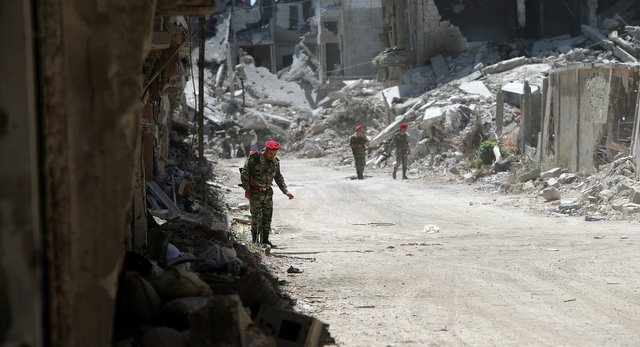In February 2014, the Syrian government’s strategy of starvation paid off when hundreds of civilians and some rebels accepted a deal to leave the besieged Old City of Homs. While some incidents were reported, most of the evacuees seem to have been provided safe passage
Others are now taking the government up on this offer, apparently having decided that their position is untenable and that they should get out while they still can.
Hundreds of Rebel Defections
Since February, Syrian state media has sent out a steady drumbeat of reports about fighters in the Homs region turning themselves in, including many from the Old City.
For example, the SANA news agency said 233 fighters in the Homs Province had their “files settled” on April 1, meaning they were released after they handed in their guns, submitted to interrogation, and promised to “not get involved in any act that might harm the homeland’s security and safety.” Twenty-three more releases were reported a week later. In the past few days, SANA claimed that a further 42 former fighters from Homs have been set free.
“They tempted them with food and drink, and saying, ‘Don’t you want to see your families?’” one activist still in Homs told the Associated Press, adding that it “really did weaken hundreds of them, and it affected the morale of the rest of the rebels.”
Talks Break Down
While individual fighters are tempted by the government’s offer, the dominant rebel groups in Homs have tried to bargain collectively for a deal that would give them safe passage out of the Old City. The government seemed to accept the idea but with important caveats.
One of the largest rebel groups in Old Homs, the Haq Brigade (which is part of the Islamic Front, a major national alliance), had insisted on bringing heavy weapons along with it, but the government would only allow brigade members to carry light arms out of the city. The rebels also reportedly sought to bring in the United Nations to monitor the deal, which the government refused.
According to the United Nations, an agreement was “on the verge of being signed” despite these problems, but a few days ago the talks suddenly broke down. Government forces are now back to trying to capture territory with military means.
Homs Province Governor Talal al-Barazi accuses rebel hardliners of having derailed the talks by randomly shelling progovernment neighborhoods around the Old City and sending a car bomb into an Alawite area. Such attacks serve no discernible military purpose except, perhaps, retaliation and the maintenance of a balance of terror. But given the government’s reliance on Alawite militiamen from the National Defense Forces, the attack may have been a way to provoke a popular backlash and force the army to abandon its successful strategy of waiting out the slow drip of rebel defections.
Old City Defenses Softening Up
Whatever the cause behind the collapse of the negotiations, the government is now turning up the pressure, either to force more rebel capitulations or in hopes of capturing the last rebel strongholds by military means. It may very well be premature, but at this point the numbers certainly seem to favor Syrian President Bashar al-Assad.
According to the Washington Post, activists in Homs estimate that between 300 and 1,000 rebels left the Old City in the last month alone. According to the Post’s sources, fewer than 1,000 fighters now remain in the Old City. For its part, the Syrian government claims there are about 2,000 “terrorists” left, most of them foreigners, in addition to some 170 civilians.
Both sides seem to agree that the rebel stronghold in the Old City of Homs, which has withstood nearly two years of government siege and shelling, is close to falling—and although the rebels are well-entrenched, some think the breakthrough could come sooner rather than later. “We expect Homs to fall,” an activist in Homs told the Associated Press on Tuesday. “In the next few days, it could be under the regime’s control.”






